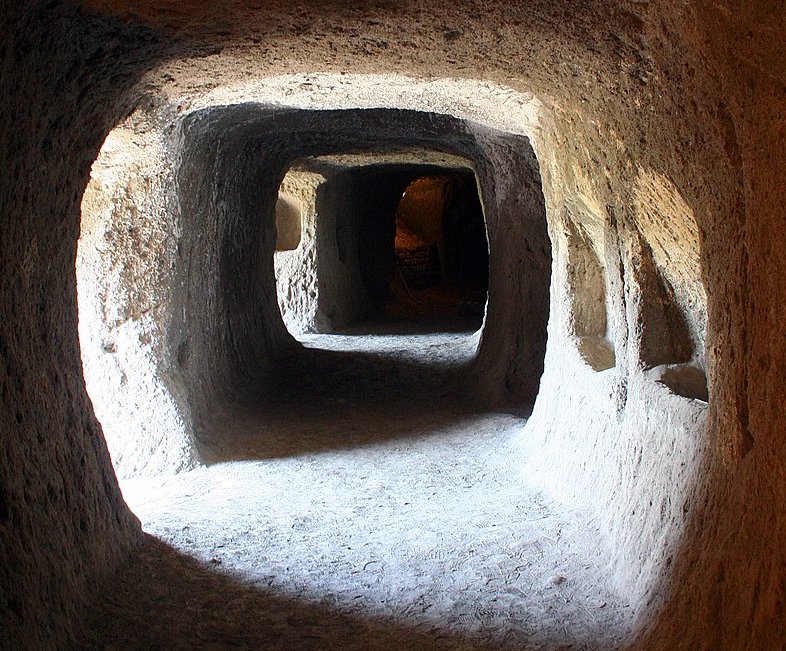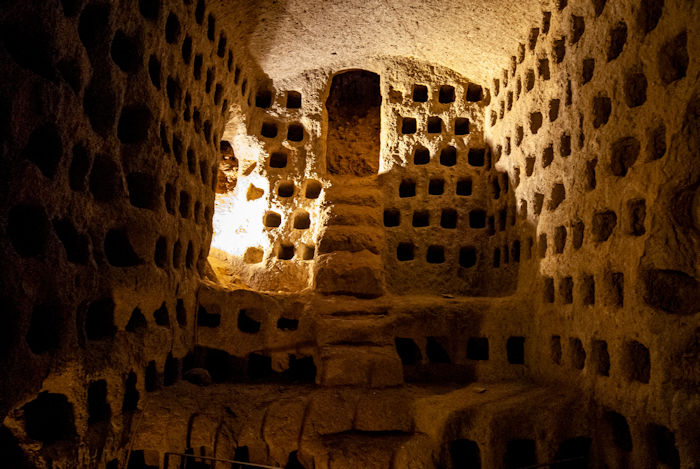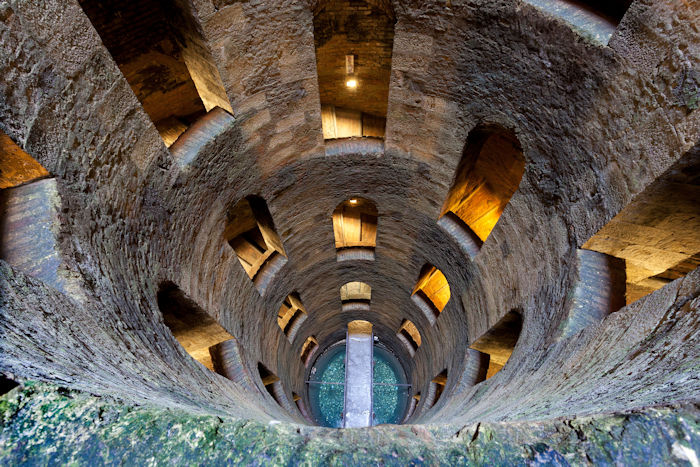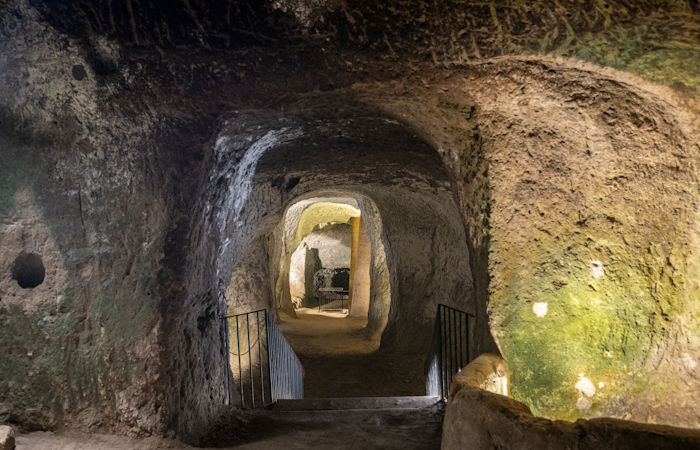Folks , this is a fascinating new discovery :-
Underground Orvieto – Etruscan ‘City Under A City’ With Labyrinth, Tunnels, Pyramidal Structures, Oil Mills And Water Supply
A. Sutherland - AncientPages.com - There is a vast network of neolithic tunnels crisscrossing several European countries, built millennia ago.
The underground tunneling system. The underground city of Orvieto, Italy – Image credit: Roberto Ferrari - CC BY-SA 2.0
The old city of Orvieto, Italy, once a significant center of the Etruscan civilization, has much more. It has a fascinating underground complex of mysterious caves connected by tunnels that now reveal surprising archaeological discoveries.
Orvieto is located on an isolated tuff mountain, the vertical walls of which are partly natural, partly artificial. This mountain hides in its depths an underground city with a secret labyrinth of excavated caves, probably built in part by noble families who used these as secret passages in case they were attacked or the city was besieged.
The Umbrian ancient town with a long history of Etruscan, medieval, and Renaissance roots has fascinating underground hidden under the massive tuff cliff.
Pozzo della Cava, the Etruscan cistern. Image credit: Orvietano - CC BY-SA 3.0
Available ancient sources inform that during the 6th- 4th centuries BC, the town of Orvieto was a culturally and economically developed Etruscan city.
There are tunnels, caverns dating back to about 2500 years ago, countless stairs and cisterns, and caves all dated to the Etruscan era and created by man. It is fascinating that the labyrinth is equipped with ancient oil mills, silos, and wells that were once fully functioning for the needs of people.
Discovery Was Made Accidentally
Discovered accidentally in the 1970s¨, the underground city of Orvieto contributed to the region with a great historical and archaeological legacy. It all started when a vast landslide hit the Umbrian town of Orvieto in the 70s, and a certan mysterious legend.
Credit: Adobe Stock - Aerial Pictures
People in the area began to talk about an old urban legend mentioning an empty Orvieto located' below.' Researchers decided to explore the underground of the city. Thus, under its surface, they found an unknown Orvieto, with a labyrinth divided into more than 1200 caves, tunnels, wells, cisterns for rainwater conservation, and mysterious openings and overhanging walls and windows with irregular forms.
It was an extraordinary discovery worth further investigation to shed more light on this still mysterious civilization of the Etruscans.
The excavations of the underground city of Orvieto revealed many historical structures like a medieval oil mill with millstones, pipelines, hearth, press, feeders for animals, water pipelines, and containers used for fruit pomace. Cisterns dated to the 5th century BC and a series of other cisterns from the Middle Ages and the Renaissance times were found too.
Pozzo di San Patrizio (English: "St. Patrick's Well") is a historic well in Orvieto, Umbria, central Italy. Credit: Adobe Stock - robiextrafa
One of the most exciting parts of the underground Orvieto is the co-called Hadrian's Labyrinth, full of cavities formed by ancient walkways, silos, wells, throats, and cisterns. The Well of the Quarry, on the other hand, is approximately 36 meters deep, whose wall was marked by the trace of a well with footholds, considered typical of the Etruscan time. Famous is also, St. Patrick's Well. Its name was inspired by medieval legends that St. Patrick's Purgatory in Ireland gave access down to Purgatory, indicating something extremely deep.
Sensational Pyramidal Structures (Hypogea)
Excavations conducted approximately eight miles northwest of Orvieto, southwestern Umbria, Italy, focused on a series of pyramidal hypogea beneath the city of Orvieto and a survey of Etruscan tombs in Castel Georgio. The archaeological exploration of a series of Etruscan underground pyramidal structures showed they are dated to before the 5th century BC.
Other puzzling structures are strange "pyramidal hypogea that the Etruscans built before the five century BC. According to an international team of archaeologists led by Prof. David B. George of St. Anselm College and co-director Claudio Bizzarri of PAAO and colleagues, the function of these Etruscan structures remains a mystery
"As for the underground pyramidal structure (hypogeum), we discovered it three summers ago and still have no idea what it is. We do know what it is not.
"It is not a quarry; its walls are too well dressed. It is not a well or cistern; its walls have no evidence of hydraulic treatments. Currently, we are 15 meters down. Below a medieval floor, we have a mix of material from the prehistoric to the 5th century BC."
Extensive excavation works revealed sculptures, monumental structures, inscriptions, mosaics, coinage, ceramics, frescoes, and numerous other artifacts. Researchers hope to solve the mystery of the strange pyramidal structure and other underground puzzling structures with the help of unearthed artifacts and analysis of the soil at the site.
Credit: Adobe Stock - SeanPavonePhoto
Otherwise, over a hundred and fifty inscriptions in the Etruscan language could also help shed light on the life of the Etruscans, one of Europe's most mysterious ancient peoples, who are believed to have migrated from Lydia, in modern western Turkey.
According to some theories, these people settled in northern and central Italy nearly 3,000 years ago.
However, the 1st-century BC historian Dionysius of Halicarnassus (c. 60 BC – after 7 BC), a Greek living in Rome, postulated that the Etruscans were indigenous people who had always lived in Etruria and were different from both the Pelasgians and the Lydians. According to Dionysius, the 5th-century historian Xanthus of Lydia, who was regarded as an essential source and authority for the history of Lydia, never suggested a Lydian origin of the Etruscans.
Orvieto - 'city under the city' still keeps its secrets.
Regards





